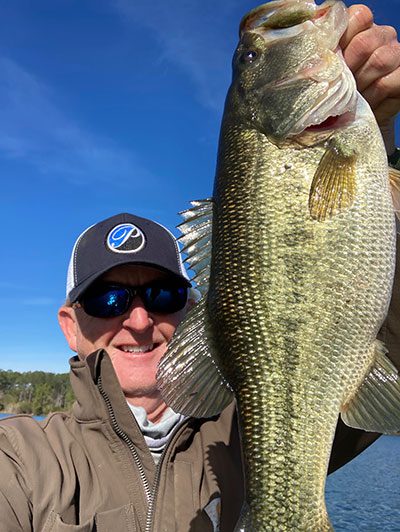You’re drifting the shallows and there she is…She must be over ten pounds, and she’s just lying there in four feet of water waiting to be caught. To many, this is the most exciting scenario possible; fishing for bedding bass during the spawn. It’s the magical time of year when bass move up from deeper into shallower water to lay and fertilize eggs. It is thought, much like the rut with deer, to be one of the easiest times to catch largemouth.
When water temps hit 58-60 degrees, young bucks begin building nests, then find a female with ripe eggs to nudge into the nest. She lays eggs. He fertilizes them, then looks for another female. He may get three or four females to spawn in the same nest. The spawn all occurs within cycles of the full moon.
The main trigger is water temperature, so the spawn and hatch occur at different times in different regions. In late January, when Virginia lakes may be frozen, Northern Florida guides may see fish on beds. “I may see beds in early January, and I may see them in April,” says Captain Keith Austin, a guide from Crystal River.” There are so many factors you can’t pin it down to a specific period.” Allen Martin (Florida Fish and Wildlife) agrees. “Florida is its own world,” he says. “Winter swings are drastic, depending on where the weather comes from. We can have winter highs in the 70’s, then a front pushes down and it’s in the 40’s.” Martin agrees with Austin about timing. “It’s not unusual to see fish on beds January through April.”
400 miles north, it’s a different story. It’s February 5th, and South Carolinian Dave Thomas checks water temperature at his lake. It’s 48 degrees. “We’re right at the cold point, “he says. “It should start moving up this week. We’re looking at 60’s and 70’s this weekend,” Thomas, a serious sight fisherman, fishes as much as career allows. “Probably mid-March before we see our first beds, maybe earlier.” Scott Lamprecht, SC DNR Fisheries biologist, agreed, saying “Mid-March until mid-May is a typical range for us in this region.”
The same day, Virginia Fisheries biologist Scott Herrmann is out sinking brush piles… Water temp is 46 degrees. “Last year, we had a really cold spring, with ice into March. That pushed back the spawn. But generally, the first week in April through late May is when it happens,” he said. Herrmann also pointed out how many factors are involved and used one word when asked about weather this year: erratic. “12 degrees in Richmond this morning, but 60’s this weekend.”
Travel 700 miles from Richmond up the coast and you’re in Maine. The spawn here probably begins long after it’s finished in mid-Atlantic states, and regulations are tighter. Jason Seiders, a biologist with Maine’s Department of Inland Fisheries, said that weigh-in tournaments are prohibited between May 8 and June 14. Scott Lamprecht says this makes sense. “Up there, the recruitment window is small, the spawn is really contracted.” Seiders said mid-May until mid-June is the typical spawn in Maine, but timing can be unpredictable there as well. A few years ago, guide Don Kleiner reported water temperature still at 54 degrees on May 25th, which meant fish could be on beds in early July, 24 weeks after the northern Florida spawn.
So, start in January in Northern Florida and work north. You’ll have about 24 weeks of bed fishing. That is, of course, if nature cooperates. And if you succeed, don’t stop. Canada awaits!
